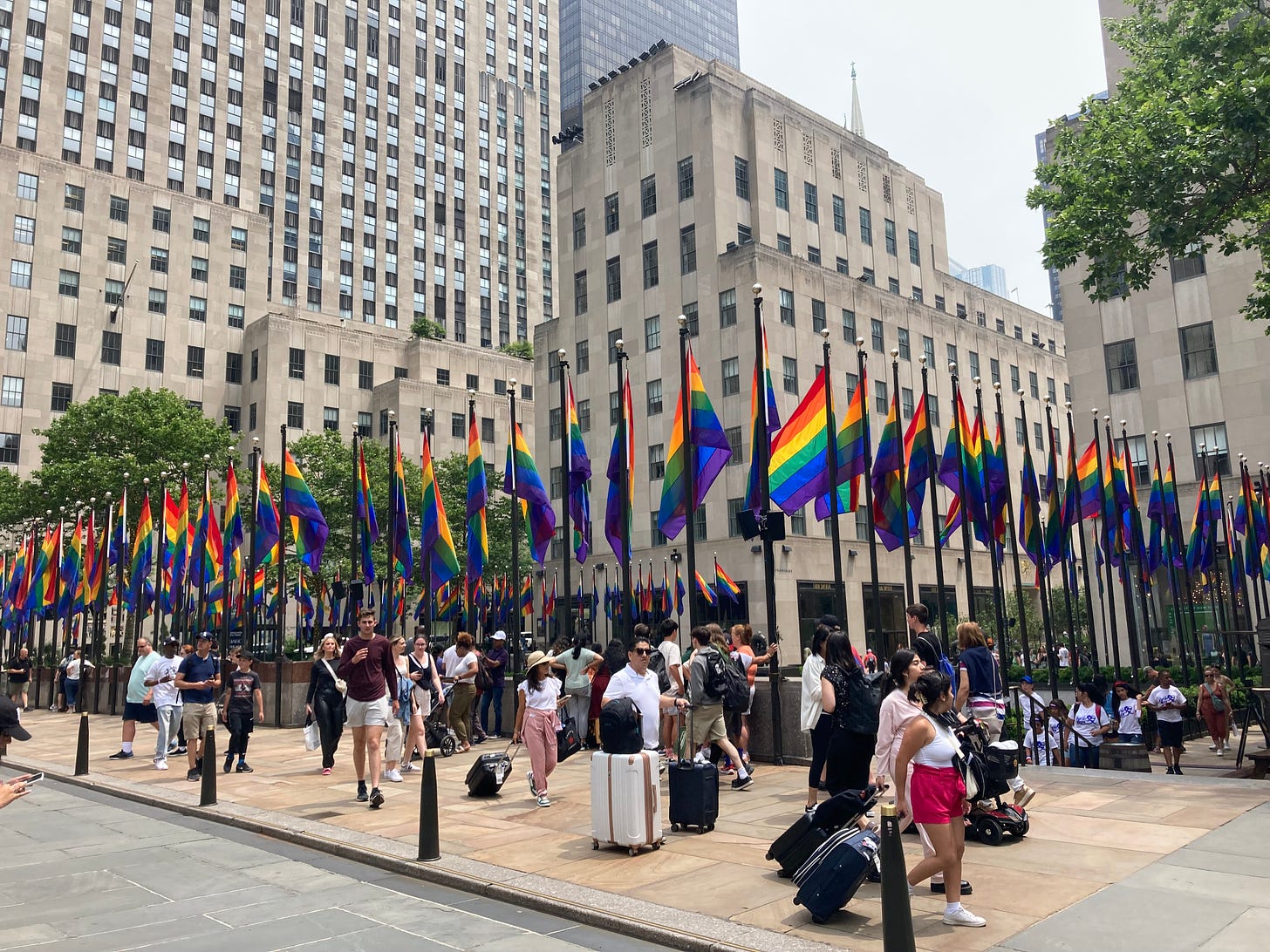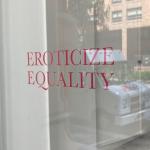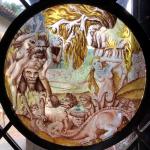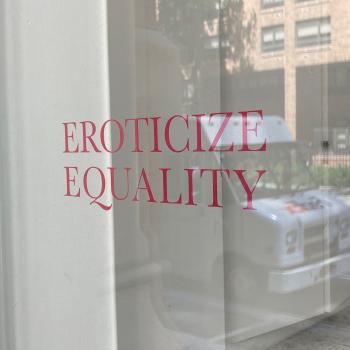if you’re interested in preordering a copy of cracks in pomo: the zine or in making a financial contribution, email stephenadubato at gmail dot com

“Postmodernist theories of the social self have not explicitly acknowledged the religious implications of what they are about. But if you read them closely, you will see that more and more of them are talking about the human mystery in terms that resemble those of the subtlest traditional theologies.” -Wayne C. Booth
Cracks in Pomo often uses discourses on sexuality as a specimen for examining the ways that postmodern thought and culture are cracking. While my personal moral convictions are no secret to those who have read this blog or listened to my podcast extensively, the goal when covering topics related to sexuality is not to argue for specific moral conclusions, but instead to highlight certain insights that emerge in the cracks of postmodern construals of sexuality. Namely, we draw out how postmodernism has opened a door to recovering metaphysical discourses—both pagan and monotheistic, diabolical and sacred—of sexuality which were previously closed by Enlightenment rationalism and the cult of bourgeois respectability. While postmodernism in its poststructuralist form can quickly reroute back to an Enlightenment-style flatness and moral puritanism, it can also allow a space for “re-enchantment.”
To close out the month of June (and to delve into the dawn of our “Post-Pride” moment), I thought I’d offer some texts that crack through the mainstream discourse on all things LGBT(QIA++). The texts selected present such a re-enchantment made possible by the postmodern “hatch.” Though their ultimate conclusions about sexual morality may conflict, hopefully you will recognize their foundational points of convergence.
1. Camille Paglia, “No Law in the Arena” from Vamps and Tramps (1994)
Paglia’s essay uses Freudian (and a little bit of Jungian) psychology to challenge the Post-Stonewall discourse of homosexuality. Propagated by radical activists from groups like ACT UP, and bolstered in the academy by poststructuralists and queer theorists, this new discourse solidified certain claims about the fixity and neutrality of same sex desire—driven more so by political goals than by actual facts or explicit moral convictions. Her Freudian framework situates homoerotic desire within an Oedpial conflict between a child and his parents, ultimately concluding that Lady Gaga was wrong. No one is born this way, though certain genetically predetermined factors combined with one’s environment and free will can lead someone to taking on a gay “identity”—a concept which she is deeply skeptical of altogether.
After my career in art schools, I know that artistic talent cannot be created, only developed. It is inborn. Similarly, I conclude that men are not born gay; they are born with an artistic gene, which may or may not lead to an artistic career. More often, they are connoisseurs, aesthetes, or simply arch, imperious commentators with stringent judgments about everything. (At a Yale party, a gay fellow whom I hardly knew muttered waspishly to me about a woman across the room, “That dress does nothing for her!”) There are gay men without such talent, but they are a minority. The effeminacy of gay men — which emerges as soon as the macho masks drop — is really their artistic sensitivity and rich, vulnerable emotionalism.
In Sexual Personae, I studied the psychic duality of the artist, who combines male and female in the act of creation. It is possible that gay men are caught midway between the male and female brains and therefore share the best of both. Talent in the visual arts may be related to a sensory or perceptual openness, detectable (as responsiveness to light and color) in early childhood and perhaps related to autism, where the flux of sensations is cognitively uncontrolled. The gay male brain seems to me permanently switched “on.”
Here is my speculative scenario, constructed after teaching and advising so many apprentice artists. A sensitive boy is born into a family of jocks. He is shy and dreamy from the start. His father is uncomfortable with him, and his brothers are harsh and impatient. But he is his mother’s special favorite, almost from the moment he is born. He and she are more alike. Repelled by male roughhousing, he is drawn to his mother’s and sisters’ quietness and delicacy. He is fascinated by his mother’s rituals of the boudoir, her hypnotic focus on the mirror as she applies magic unguents from vials of vivid color, like paints and palette. He loves her closet, not because he covets her clothes but because they are made of gorgeous, sensuous fabrics, patterns, and hues denied men in this postaristocratic age. Later, he feels like an outsider in the schoolyard. There is no male bonding; he tries to join in but never fully merges with the group. Masculinity is something beautiful but “out there”; it is not in him, and he knows he is feigning it. He longs for approval from the other boys, and his nascent sexual energies begin to flow in that direction, pursuing what he cannot have. He will always be hungry for and awed by the masculine, even if and when, through bodybuilding or the leather scene, he adopts its accoutrements.
Thus homosexuality, in my view, is an adaptation, not an inborn trait. When they claim they were gay “as far back as I can remember,” gay men are remembering their isolation and alienation, their differentness, which is a function of their special gifts. Such protestations are of little value in any case, since it is unlikely that much can be recalled before age three, when sexual orientation may already be fixed. Heaven help the American boy born with a talent for ballet. In this culture, he is mocked and hounded and never wins the respect of masculine men. Yet this desperation deepens his artistic insight and expressiveness. Thus gay men create civilization by fulfilling the pattern of Coleridge’s prophesying, ostracized poet, dancing alone with “flashing eyes” and “floating hair.”
She expands on her Freudian theory of homosexuality in her famous interview with Jordan B. Peterson. It might also help to read the first chapter of Sexual Personae where she fleshes out her anti-Rousseau, pro-De Sade philosophy of nature and sexuality. I’d also recommend reading Paglia’s chapter on the “beautiful boy a destroyer”—a view into the classical pagan ephebophilic archetype and how it trapped figures like Wilde, Verlaine, and Baldwin.
2. Bronze Age Pervert, The Bronze Age Mindset (2018)
DISCLAIMER: I do not endorse BAP’s toying with “race science” or fascist aesthetics. That being said, I don’t take BAP seriously as an intellectual, nor do I think he intends to be taken seriously. I see him more as an interesting, thought-provoking, and at times rather comical internet troll.
BAP—whose ideas are mired in Nietzschean pastiche and homofascist aesthetics (a la Mishima, Yiannopoulos)—builds his theory of the genesis of same sex attraction on Paglia’s, while offering some minor modifications. Ultimately, male homosexuality is a response, a coping mechanism, for a reality that all men today must face. The expansion of bureaucracies, industrialization, and technocratic globalization have rendered men superfluous. Postmodern man is alienated from the land and his fellow human being, and drowns in a sea of homogenization and mass atomization.
Now, Paglia’s restatement of Freud is correct, but she misses an important element of the story, which is why such a boy turns away from the masculinity of his peers in the first place. It is not horseplay or the roughness of male competition as such that makes him turn away, but the utterly fake or artificial character of such displays, usually, in our time. Such boy perceives what his peers don’t, the conditional and entirely dependent character of life in our age. It is not the masculinity, the competition for status among men, the physical roughness, that makes him turn away… but the fact that all such play is happening in already owned space. It is this aspect of our time that is crucial to understand. When I speak of something like owned space, it must not remain mere word. When you understand something: I mean you must see and feel it like you would a landscape you know from youth, how to navigate all its nooks, the different heights of earth, the banks of streams, where the trees are and how it feels inside them, how long it takes walking from this or that group of beech to the abandoned factory, so that the map is already in your body. This is only way to really understand something. I believe boy like this is one of the types that sees through the charade the lords of lies have dangled in front, the shadow-play to dazzle the many, and he is turned off, maybe not by manliness, but the buffoonish, deluded character of modern masculinity. The defeated male that is turned into a peon and a neutered beast for women and hidden masters is a terrible thing to see. The jockeying for status, the physical fights, the adventures boys are supposed to have in a state of nature…all of this is in nature meant as preparation for life, for a life of conquest and expansion…Precisely a character born for conquest, for expansion, a precocious type of boy who seeks real development and the real domination of the space around him, who understands in his blood that play and manliness are to this end, precisely such a boy will have his expectations about life crushed and thwarted as soon as his eyes open…They submit to the yoke and their sham simulated masculinity is now a parody of the true manliness, which in a state of ascent develops into the will to actually dominate space around oneself, not into a caricature for the benefit of women. But this domination is not possible when space is already owned. This intuition of owned space comes on one very early: with eyes open, it’s like an evil spirit inhabits everything. I think there are many types of energetic and perceiving boys who reach this stage, who are turned off by the moral and biological self-castration of their conventional peers, who sense the suffocating limitations of modern space…[T]hen there is the added observation that when, late in adolescence or some time in youth, such boy decides he is “gay,” that is but the final act of self-misunderstanding. The drama of his spirit is reinterpreted on sexual terms. He has convinced himself that the feeling of suppression and dread that had accompanied him his whole life was because his sexual desires or “sexuality” had been repressed by “society.” He forgets how these sexual desires developed in the first place, that these desires themselves were a circuitous result of the truth that dawned on him in silence, the truth of the utter subjection and domestication of the space in which he found himself. In becoming “gay” he believes he is escaping that sense of primal limitation and subjection that he felt as a small boy: he has reinterpreted his entire drama as a maudlin story of sexuality suppressed or oppressed by retrograde social and political norms. In this he becomes an unwitting pawn himself of the very power that as a young boy he had intuited to be the enemy, the great and suffocating shadow of our time, that smothers all higher life out. The gay is the spiritual foot-soldier of the new regime, when he is born to be its enemy. This is the unusual part of this realization, that some of the most sensitive and perceptive youths, those maybe imbued with spark of inspiration and a conquering, expanding spirit, end up becoming the vanguard of that which has smothered and broken them. In a previous age they wouldn’t have been gay at all in the first place. The story of such boy is story of all higher types in our time.
3. Urban (aka Michael) Hannon, “Against Heterosexuality” (2013)
In his First Things article (one of the most read in the history of the site), Hannon (who is also a friend of and 2x guest on the pod) delineates a “horseshoe theory” of postmodern queer theory and Christian morality. Relying on the historical insights of Foucault, he argues that both postmodernism and Christianity are correct in claiming that there is no basis for a fixed “sexual orientation.” The concept is deeply modern, rooted in medical, scientific research and bourgeois moral values, which conflicts with postmodern and Christian construals of identity and morality. Though I think Hannon doesn’t give enough attention to the psychological and cultural implications of persistent same sex desire, and runs the risk of being overly abstract, I agree with his assertion that the concept of sexual orientation has no ontological basis (though it does have a psychological and cultural/aesthetic basis). On this last point, I’d recommend looking at Mark Yarhouse’s use of “interpretive lenses” of varying magnitudes to understand how one can hold in tension the ontological, psychological, and social dimensions of identity.
Although I expect many conservative Christian thinkers will find Foucault a strange bedfellow, I want to suggest that our endorsement of the radical left on this subject should be an enthusiastic one, although it must also be carefully circumscribed. In essence, we should happily join our voices to those of the poststructuralist queer theorists in their vigorous critiques of the naïve orientation essentialists, who mistakenly think “straight” and “gay” are natural, neutral, and timeless classifications.
Their disillusioned historicism makes these sexual genealogists uniquely positioned to see through the deceptions of sexual orientation, and while we Christians do not need them in some essential sense, nevertheless, in an accidental way, they may prove a great asset to us at present. Ironically, these radical leftists may be the only ones who can heal the blindness we have foolishly inflicted upon ourselves of late by uncritically adopting the language of hetero- and homosexuality.
However, while we can and should recommend the queer theorists’ diagnosis of the absurdity plaguing our popular sexual categories today, nevertheless we cannot sign on to their plan of treatment. Jonathan Ned Katz, Hanne Blank, and contemporary queer theorists generally, aim to genealogically explain away the rigid orientation schema precisely because they believe this will give them the freedom and the power to make, unmake, and remake their sexuality as they see fit.
They want to tear down these failed social constructs not so that something better can be constructed in their place—or, perhaps, rediscovered amid the rubble—but because they hope to achieve an even greater degree of sexual libertinism than we have today, even if it comes at the cost of endorsing a wretched sort of sexual nihilism. To riff on Dostoevsky, these radicals would like to believe that if orientation does not exist, then all things are permissible.
The Christian cannot follow them down this miserific road, of course. But neither, I believe, can the Christian remain content in today’s deceptive, doomed orientation taxonomy. Mark my words: The queer theorists will have their way in dismantling the thing before long. Even our popular culture is beginning to show signs of stress here. The ever-increasing laundry list of orientations demonstrates the insufficiency of those neat and discrete categories. And the now familiar concept of the “hasbian” suggests that these identities are far less static than we were initially led to believe. (Think, for example, of our new ex-homosexual first lady of New York City.)
Check out my interviews with Hannon on his article and on the 3 discourses of homoeroticism as presented in Call Me By Your Name, Brideshead Revisited, and Love Simon (more on films at the end of this post).
4. Marc-Andre Raffalovich, Uranisme et Unisexualite (1896)
Raffalovich was once a part of the late 19th century aesthete social circles in England and France, until a few run-ins with Oscar Wilde (who often mocked Raff’s ugliness and Jewishness) cast him out of the in-crowd. A devout Catholic, he dedicated his life to virginity as a third order Dominican, and lived in a committed chaste friendship with Fr. John Gray (one of Wilde’s “pretty boys” before his conversion, and inspiration of The Picture of Dorian Gray).
Raff—riffing on Jesus’ pronouncement in Matthew 19 about eunuchs—insists that some people were born sexually “inverted,” which corresponds slightly to one being born with the spirit or psyche of someone with the opposite sex. Some inverts are not exclusively attracted to people of the same sex…they can make great spouses to people of the opposite sex, so he claims. His main assertion is that inversion is not a “disorder” in se—the real question is how one chooses to channel their inversion.
The “superior” invert dedicates himself to chastity, art, spirituality, and charitable works, while the “inferior” indulges in acts of vice, pleasure, and wickedness. I have relied on Raff to further my point that those predominantly drawn to the same sex—because of their alienation from the “natural” experience of opposite sex union and procreation—live in a constant tension between the unnatural and supernatural, the diabolical and the sacred, but never the “normal” or mundane. His assertions are also echoed in Eve Tushnet’s (cited below) claims about SSA men being oriented to intimacy with Jesus and women with Mary.
You can also read Aaron Taylor’s excellent summary of it here: “Whose Gayness? Which Homosexuality?”
5. Quentin Crisp, The Naked Civil Servant (1968)
Crisp is the last holdout of the Pre-Stonewall construal of homosexuality: that it is a form of deviance that is neither neutral nor normal. His writings are a precursor to the trad Cath-queer theory horseshoe, and echoes some of Raff’s insights about the different manifestations of inclinations that don’t correspond to “nature.” He claims that gay men desire a “Great Dark Man”: a heterosexual man who desires them—an impossibility, which brings them to the brink of a dark abyss or to pursuing the ultimate “Dark Man,” the mystery of God. “This being, if he exists, is so rare that one might as well enter a monastery on reaching puberty.”
“I can never get it into my head that I shall one day die,” he says to his friend’s Polish lover. “Neither can I,” she replied, “but I practice like mad.” Their “progress toward the grave” became mirror opposites of each other: the Polish lover converted to Catholicism and became a nun, and Crisp “took to sex” which “became a time-filler and ceased to be the pursuit of an ideal.” One day the nun came to visit Crisp and her former lover. “The trouble with human nature is that you’re stuck with it,” she told them. “Every hour has been agony, but I could not have done otherwise.”
Crisp responded that he found it to be “much the same with sex,” except that in pursuing the mythical Great Dark Man, rather than the Mystery of the Divine, “for the ennobling influence of anguish I was substituting the degrading effects of discomfort and exhaustion.”
Others worth reading:
- Sigmund Freud, “Three Essays on the Theory of Sexuality”
- Eve Tushnet, “Romoeroticism” and “Velvet and Pus”
- Michel Foucault, The History of Sexuality (or read Aaron Taylor’s summary of it here: “Gay or Nay? A question of identity” )
- Fabrice Hadjadj, La Profondeur Des Sexes (read an abridged version of his theory in this interview with Ethika Politika)
- Carlo Lancelotti (on Augusto Del Noce), “The Final Bourgeois Revolution”
- Andrea Long Chu, Females (check out my review of it in CWR)
- Yukio Mishima, Sun and Steel (also his short stories in Acts of Worship)
- Milo Yiannopoulos, “The Catholic magazine interview with Milo they refuse to print” (DISCLAIMER: this is an endorsement of neither Milo nor Church Militant ie you can’t cancel me for this one)
- Ellis Hanson, Decadence and Catholicism
- Frederick Roden, Same Sex Desire in Victorian Religious Culture
Lastly, I’d recommend you watch (with discretion, of course [for the trads]) the following films which cover themes related to the aforementioned texts:
1. I Am Michael: the horseshoe theory in thinkers like Crisp, Hannon
2. Those People: a modern, NYC, Jewish spin on Brideshead Revisited…if Waugh had taken a decadent, pagan route; whiffs of Crisp’s theme of abysmal finitude at the end of the tunnel of homoeroticism—which in itself is a sign of “something greater”; also Paglian tropes of the Beautiful Boy as Destroyer
3. Fresa y Chocolate: Crisp’s “Great Dark Man”…and more horseshoe related stuff
4. The Happy Prince: Raffalovich’s two types of inverts
5. La Ley Del Deseo: Freudian causation theories, Paglia
$upport CracksInPomo by choosing a paid subscription of this page, or by offering a donation through Anchor. Check out my podcast on Anchor and YouTube and follow me on Instagram and Twitter.
photo taken in Rockefeller Plaza.












